|
|
|
Sort Order |
|
|
|
Items / Page
|
|
|
|
|
|
|
| Srl | Item |
| 1 |
ID:
176111
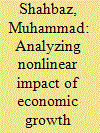

|
|
|
|
|
| Summary/Abstract |
Several Asian countries are facing challenges regarding the accomplishment of the objectives of Sustainable Development Goals (SDGs), and India is facing a similar situation. Following this, this study talks about designing an SDG framework for India, which can be used as a benchmark for other Asian countries. In this pursuit, this study looks into whether per capita income, energy use, trade openness, and oil price have any impact on CO2 emissions between 1980 and 2019. The nonlinear autoregressive distributed lag approach proves that the fluctuations in independent variables have an asymmetric long-term impact on CO2 emissions. The results reveal that the prevailing economic growth pattern in India is environmentally unsustainable, because of its dependence on fossil fuel-based energy consumption and imported crude oil. Import substitution has been identified as one of the first stepping stones to address this issue, and accordingly, a multipronged SDG framework has been designed based on the direct and extended version of the study outcomes. While the Central policy framework shows a way to address SDG 7, SDG 8, SDG 12, and SDG 13, the Tangential policy framework shows the way to sustain the Central policy framework by addressing SDG 4.
|
|
|
|
|
|
|
|
|
|
|
|
|
|
|
|
| 2 |
ID:
176107
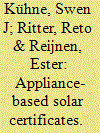

|
|
|
|
|
| Summary/Abstract |
In recent years, an increasing amount of solar energy has been produced around the globe, but too few consumers actually buy it. Three studies now show how this purchase can be promoted with an approach similar to the carbon offset program in aviation. After a fictitious purchase of differently priced appliances (e.g. electric toothbrush or TV set) in an online store, participants could buy a solar certificate for this appliance, whereby its price depended on the appliance's energy consumption as well as the selected term (e.g. 1 or 3 years) of the certificate. By purchasing such a certificate, the amount of solar energy consumed by this appliance for the selected term would be fed into the Swiss electricity grid. Study 1 showed that participants were willing to buy such a certificate, especially certificates with longer terms. That willingness, however, depended on the “solar certificate price/appliance price” ratio. While Study 2 showed that this purchase is influenced by promotions (e.g., a specific reduction in price), Study 3 showed that this purchase did not lead to a less environmentally friendly behavior afterwards. Appliance-based solar certificates easily available at the point of sale can encourage consumers to buy more solar energy.
|
|
|
|
|
|
|
|
|
|
|
|
|
|
|
|
| 3 |
ID:
176112


|
|
|
|
|
| Summary/Abstract |
Besides being the world's most populous country, China is also the top emitter of CO2 with power generation being the main culprit. Stretching between 2017 and 2050 a projection of the future Chinese electricity production is presented. Power generation forecasts derive from the Business As Usual (BAU), the Goals (Goals), the Renewables (RESc) and the Coal Free (CFr) scenarios. The RESc, consisting of renewables, hydro and batteries, is unable to meet electricity demand unless supplemented by fossil fuels. Bound by various constraints, natural gas is unlikely to act as a transition fuel to a low-carbon economy. At 0.207 $/kWh, the RESc yields the most expensive electricity which is twice as costly as the CFr and the Goals and 3 times more expensive than the BAU. Concerning CO2 emissions, the BAU will emit 7.26–12.34 Gigatonnes (Gt) compared to 2.57–4.76 Gt for the Goals, 0.79–2.03 Gt for the RESc and 0.68–1.47 Gt for the CFr by 2050. Both the CFr and Goals are the only ones that fulfil China's COP21 targets. Concluding, Land Use, Land-Use Change and Forestry (LULUCF) are estimated to lower CO2 emissions by 1.06 Gt indicating that China's electricity sector can realize net-zero emissions only by phasing-out coal.
|
|
|
|
|
|
|
|
|
|
|
|
|
|
|
|
| 4 |
ID:
176097


|
|
|
|
|
| Summary/Abstract |
Decarbonisation policies often emphasise the uptake of new end-use technologies, seeing people as consumers of technologies with predictable impacts. In the UK, smart hybrid heat pumps (SHHP) have attracted policy interest as a technology potentially offering multiple benefits for home heat decarbonisation. This paper draws on domestication theory, a perspective that frames people as users who actively learn about technologies, to analyse interviews and observations with installers and users involved in the first UK trial of SHHP. This perspective reveals that users’ learning about SHHPs may erode part of the energy savings they offer and have implications for future technology uptake, including the trajectories of heat decarbonisation currently envisaged by policy makers. However, it also reveals opportunities for policy making to influence user learning, including paying closer attention to material elements such as radiator controls and space to air laundry alongside improved information provision. This could be supported by engaging with users as their learning emerges over time. Overall, the paper highlights the policy relevance of technology use as well as uptake and adds to calls for energy policy to think beyond information provision and economic incentives to engage with households, implying a less deterministic approach to policy making.
|
|
|
|
|
|
|
|
|
|
|
|
|
|
|
|
| 5 |
ID:
176123


|
|
|
|
|
| Summary/Abstract |
Competitive bidding programmes, or auctions, are becoming the dominant method for procuring utility-scale renewable energy generation capacity and have coincided with significant cost reductions of renewable energy (RE) technologies. The use of price in auctions as the main awarding criterion has been criticized for apparently leading to market concentration and dominance in project ownership. We investigate: to what extent South Africa's renewable energy auction programme has contributed to market concentration and dominance; if market concentration and dominance have a negative impact on electricity cost in the auction; and to what extent measures taken to counteract market concentration and dominance have led to improved competition and diversity of project ownership.
|
|
|
|
|
|
|
|
|
|
|
|
|
|
|
|
| 6 |
ID:
176122


|
|
|
|
|
| Summary/Abstract |
This article analyses Denmark's involvement with the Nord Stream 2 gas pipeline project. Impressing the Baltic as a sea of strategic significance and a potential international flashpoint, the controversial project thrust Denmark into a position of decision-making importance beyond its size and material power. Geopolitical and environmental considerations, and normative impetus derived from a liberal democratic political culture, influenced Danish attitudes towards the project. The impact of these concerns substantially delayed the granting of a permit for pipeline construction in the Danish marine space, frustrating governments and business in Russia and Germany. Ultimately, approval was granted because Denmark is a rule of law state. Yet the delay is crucial. More broadly, the article illustrates how, in the energy policy domain, illiberal regimes attempt to exploit liberal-democratic legal systems through nominally commercial entities, and considers the responses by other actors in this case.
|
|
|
|
|
|
|
|
|
|
|
|
|
|
|
|
| 7 |
ID:
176118


|
|
|
|
|
| Summary/Abstract |
The petrochemical industry plays a pivotal role in achieving high value-added products from oil and gas reserves. With attention to oil and gas reserves in Iran, it is clear that the petrochemical industry has not grown up adequately. This study aims to determine effective factors on petrochemical industry development and model the mechanism of capacity expansion budget creation using a system dynamics approach. A quantified system dynamics model has been built based on causal relationships and the mechanism of development budget allocation among categorized products. This structure is used to simulate the model and investigate essential variables related to each product, such as production capacity value, production rate, domestic sale revenue, and export. According to the results of a simulation, in 2025, Iran will have a capacity of approximately 104 million tons of petrochemical products that is not desirable. In this study, a policy of improving budget plan and allocation is introduced as the most effective solution to achieve the petrochemical industry development. By implementing this policy the production capacity and total revenue would respectively be improved by 4% and 13% in 2025 in comparison with the base run.
|
|
|
|
|
|
|
|
|
|
|
|
|
|
|
|
| 8 |
ID:
176125
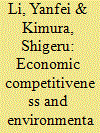

|
|
|
|
|
| Summary/Abstract |
Hydrogen as an energy carrier faces challenges such as high costs of hydrogen supply, high cost of fuel cell electric vehicles (FCEVs), and substantial infrastructure requirements. However, leading countries have announced long-term plan and targets in developing hydrogen energy. Should the Association of Southeast Asian Nations (ASEAN) follow up such developments? This study asks if hydrogen-based road transport, especially FCEVs in the fleets of passenger cars, buses, and trucks, could be economically justified in the ASEAN member states. If not, what strategies to take for ASEAN member states? The study applies a well-to-wheel model and a total cost of ownership model to compare the energy consumption, carbon emissions, as well as the costs of FCEVs with those of alternative powertrains. This practice shows the scale of the cost gaps. Subsequently, it estimates the implications of predicted future developments of both hydrogen and FCEVs, in terms of costs and carbon emissions reduced. The results indicate the areas in which FCEVs are most likely to become competitive in the near future, and thus could be targeted and prioritised. By comparing the country-specific results, implications are extended to what policies are most relevant in facilitating the development of hydrogen and fuel cell.
|
|
|
|
|
|
|
|
|
|
|
|
|
|
|
|
| 9 |
ID:
176124
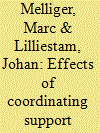

|
|
|
|
|
| Summary/Abstract |
The economic context for renewable power in Europe is shifting: feed-in tariffs are replaced by auctioned premiums as the main support schemes. As renewables approach competitiveness, political pressure mounts to phase out support, whereas some other actors perceive a need for continued fixed-price support. We investigate how the phase-out of support or the reintroduction of feed-in tariffs would affect investors’ choices for renewables through a conjoint analysis. In particular, we analyse the impact of coordination – the simultaneousness – of policy changes across countries and technologies. We find that investment choices are not strongly affected if policy changes are coordinated and returns unaffected. However, if policy changes are uncoordinated, investments shift to still supported – less mature and costlier – technologies or countries where support remains or is reintroduced. This shift is particularly strong for large investors and could potentially skew the European power mix towards an over-reliance on a single, less mature technology or specific generation region, resulting in a more expensive power system. If European countries want to change their renewable power support policies, and especially if they phase out support and expose renewables to market competition, it is important that they coordinate their actions.
|
|
|
|
|
|
|
|
|
|
|
|
|
|
|
|
| 10 |
ID:
176115


|
|
|
|
|
| Summary/Abstract |
With the rapid popularization of private cars in China, vehicles have become the primary source of air pollution and traffic congestion in the country. Major cities have successively applied vehicle purchase restrictions to restrict the use of private cars. This paper empirically investigates the environmental effects of vehicle purchase restrictions in six major cities of China, by using the data of daily PM10 concentration at city-level as the major indicator for air pollution. The generalized difference-in-differences model is employed to solve the problems of time inconsistency in policy implementation and discrete changes in policy intensity across cities. The empirical findings show that the restriction policy has significantly slowed down the growth of daily PM10 concentration of the policy-treated cities. Moreover, environmental effects of the policy show certain lags: the treatment effect comes from the second year after the policy implementation, increases significantly in the third year, and reaches another high level in the seventh year. The article argues that the environmental effects result from the induced choice of residents’ reducing the use of private cars and switching to alternative fuel vehicles. Hence, such purchase restriction policies should be complemented by improving the convenience of purchasing and using new-energy vehicles.
|
|
|
|
|
|
|
|
|
|
|
|
|
|
|
|
| 11 |
ID:
176100
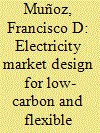

|
|
|
|
|
| Summary/Abstract |
Chile was the first country that privatized all generation, transmission, and distribution services, and introduced competition in the generation segment. Nearly four decades after its creation, many features of the original electricity market design remain unchanged. In this paper, we provide a brief history of the Chilean electricity market and explain its main limitations going forward. Some of these include the use of a cost-based mechanism for spot transactions based on a merit-order curve, low temporal granularity of spot prices, missing forward markets to settle deviations from day-ahead commitments, inefficient pricing of greenhouse gas emissions due to administrative rules, and a capacity mechanism that does not reflect a clear resource adequacy target. Many of these limitations are also present in other electricity markets in Latin America that, when privatized, mirrored many features of the electricity market design in Chile. Failing to address these limitations will provide distorted incentives for the efficient entry and operation of resources that could impart flexibility to the system, increasing the cost of decarbonizing the power sector.
|
|
|
|
|
|
|
|
|
|
|
|
|
|
|
|
| 12 |
ID:
176116
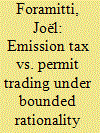

|
|
|
|
|
| Summary/Abstract |
A price on emissions can be achieved through an emission tax or permit trading. The advantages and drawbacks of either instrument are debated. We present an agent-based model to compare their performance under bounded rationality and dynamic markets. It describes firms that face uncertainty about future demand and prices; use heuristic rules to decide production levels, trading prices, and technology adoption; and are heterogeneous in terms of production factors, abatement costs, and trading behavior. Using multiple evaluation criteria and a wide range of parameter values, we find that the main difference between the two policies lies in the fact that permit prices fall after successful abatement. This can lead to higher production levels under permit trading, but can also drive emission-efficient firms out of the market. Scarcity rents under permit trading can further create higher profit rates for firms, the extent of which is shown to depend on the mechanisms for market-clearing and initial allocation.
|
|
|
|
|
|
|
|
|
|
|
|
|
|
|
|
| 13 |
ID:
176110


|
|
|
|
|
| Summary/Abstract |
Over the past decade, the shale gas boom has led to increasing public concerns regarding communities' exposure to air pollutants from shale gas development resulting in concentrations higher than the EPA's National Ambient Air Quality Standards. This study investigates the sufficiency of current policy in Pennsylvania to protect people from exposure to fine particulate matter (PM2.5) emissions from such development. We used a Gaussian plume model to simulate PM2.5 concentrations over the Marcellus shale region of Pennsylvania, and using census block data, we estimated the potential number of people who experienced exceedance of the PM2.5 standard between 2005 and 2017. Results demonstrate that these emissions could increase the number of exceedances by more than 36,000 persons in a single year which is almost 1% of the Marcellus shale regional population in Pennsylvania. This number has largely been proportional to the overall number of developed wells, but development histories show that similar levels of development could occur with reduced population exposure. Setback policy is shown to be an effective method to reduce exposure exceedances, but results suggest that it should be revised based on the number of wells per wellpad as well as the local conditions to further limit air quality impacts.
|
|
|
|
|
|
|
|
|
|
|
|
|
|
|
|
| 14 |
ID:
176099


|
|
|
|
|
| Summary/Abstract |
Saudi Arabia has regulated domestic energy prices for decades, setting them below international market levels. Energy subsidies in Saudi Arabia are generally implicit because they lead to foregone revenues for the government. Low energy prices also encourage rapid energy demand growth and wasteful consumption, while limiting incentives to invest in energy efficiency. Saudi Arabia recently started to reform energy prices, leading to large increases in gasoline and residential electricity prices in 2018. To measure the economic and environmental impacts of energy price reform, we econometrically model gasoline and residential electricity demand using Harvey's (1990) Structural Time Series Model. Our estimated equations reveal that gasoline demand and residential electricity demand in Saudi Arabia are strongly price and income inelastic, despite the major reforms that were recently implemented. Our welfare analysis also shows that the energy price reforms in 2018 in gasoline and residential electricity respectively delivered welfare gains of 8.8 and 3.8 billion SAR annually (2.3 and 1.0 billion US$). Additionally, our decomposition analysis reveals that these energy price reforms were the largest contributors to the observed decreases in gasoline and residential electricity consumption in 2018.
|
|
|
|
|
|
|
|
|
|
|
|
|
|
|
|
| 15 |
ID:
176108


|
|
|
|
|
| Summary/Abstract |
A growing literature highlights the presence of spatial differences in solar photovoltaic (PV) adoption patterns. Central to forward planning is an understanding of what affects PV growth, yet insights into the determinants of PV adoption in the literature are limited. What factors do drive the adoption at local level? Are the effects of these factors geographically uniform or are there nuances? What is the nature of these nuances? Existing studies so far use aggregate macro datasets with limited ability to capture the role of peer effects. This paper considers some established variables but also broadens the base of variables to try to identify new indicators relating to PV adoption. Specifically, it analyses domestic PV adoption in the UK at local level using data on the number of charities as a proxy to capture the opportunities to initiate social interactions and peer effects. A geographically weighted regression model that considers the spatially varying relationship between PV adoption and socio-economic explanatory variables reveals significantly more variability than the global regression. Our results show that charities and self-employment positively influence PV uptake while other socio-economic variables such as population density has bidirectional impacts.
|
|
|
|
|
|
|
|
|
|
|
|
|
|
|
|
| 16 |
ID:
176109


|
|
|
|
|
| Summary/Abstract |
This paper analyzes the energy consumption behavior of urban households in Nepal during the energy crisis induced by the unofficial Indian economic blockade in 2015. Our findings suggest that urban households have a smaller marginal utility attached to the consumption of one more unit of electricity relative to other dirty energy sources like firewood. The 2015 economic blockade had some deteriorating impacts on a household fuel choice as they were forced to degrade to firewood for cooking. However, to some extent, the blockade also seems to have acted as a push factor for some households towards cleaner sources like electricity largely due to the distrust in the supply of petroleum fuels. There is a variation in energy consumption behavior of households, which is explained by different demographic and socioeconomic attributes of the household. Households with a better educated head and those headed by a female are generally more amenable to cleaner fuels such as electricity. On the other hand, larger households and those residing outside the Kathmandu valley are less likely to make the jump to cleaner fuels. House ownership and number of rooms used were found to have no significant association with the energy consumption behavior of households residing in urban Nepal.
|
|
|
|
|
|
|
|
|
|
|
|
|
|
|
|
| 17 |
ID:
176113


|
|
|
|
|
| Summary/Abstract |
This paper evaluates the effects of cash transfers program, that is, the Benazir Income Support Program (BISP) on environmental poverty using household data. A multidimensional environmental poverty index (EPI), based on four dimensions of environmental services, namely, dwelling, water, sanitation, and energy, is developed using the Alkire-Foster method. EPI shows that about 57% of households face multidimensional environmental poverty in the sample group. Our empirical analysis, based on regression discontinuity design, indicates that BISP cash transfers have a negative and significant impact on environmental poverty. This empirical evidence implies that cash transfers increase the use of environmental services among BISP beneficiaries. The effects of cash transfers on environmental poverty vary from one province to another, which emphasizes the importance of regional differences and heterogeneities. The impacts of BISP cash transfers on various dimensions of environmental poverty, such as dwelling, water, sanitation, and energy, also differ across provinces. The government should expand social protection programs to overcome environmental poverty with a focus on the use of environmental services. However, any efforts to reduce environmental poverty through cash transfers may depend on household preferences and availability of environmental services.
|
|
|
|
|
|
|
|
|
|
|
|
|
|
|
|
| 18 |
ID:
176104


|
|
|
|
|
| Summary/Abstract |
With more renewables on the Swedish electricity market, while decommissioning nuclear power plants, electricity supply increasingly fluctuates and electricity prices are more volatile. There is, hence, a need for securing the electricity supply before energy storage solutions become widespread. Electricity price fluctuations, moreover, affect operating income of nuclear power plants due to their inherent operational inflexibility. Since the anticipated new applications of hydrogen in fuel cell vehicles and steel production, producing hydrogen has become a potential source of income, particularly when there is a surplus supply of electricity at low prices. The feasibility of investing in hydrogen production was investigated in a nuclear power plant, applying Swedish energy policy as background. The analysis applies a system dynamics approach incorporating the stochastic feature of electricity supply and prices. The study revealed that hydrogen production brings alternative opportunities for large-scale electricity production facilities in Sweden. Factors such as hydrogen price will be influential and require in-depth investigation. This study provides guidelines for power sector policymakers and managers who plan to engage in hydrogen production for industrial applications. Although this study was focused upon nuclear power sources, it can be extended to hydrogen production from renewable energy sources such as wind and solar.
|
|
|
|
|
|
|
|
|
|
|
|
|
|
|
|
| 19 |
ID:
176102


|
|
|
|
|
| Summary/Abstract |
There are cross subsidies in China's power industry and there is a gap between supply cost and the sales price of electricity to residents and enterprises. Enterprises pay for part of residents' electricity bills. As cross subsidies always have been criticized, this paper simulates counterfactual scenarios of removing cross subsidy by applying a dynamic recursive computable general equilibrium model. Based on the scenario analysis, the elimination of cross subsidy will have positive impact on economic performance, but negative on CO2 mitigation, industrial structure, and social welfare. Eliminating cross subsidies can reduce commodity prices, improve the competitiveness of enterprises, especially power-intensive enterprises. However, China is somehow an export-oriented country. Only a part of the benefits of the decrease in the product price is obtained by domestic households. Maybe removing cross subsidies is not a good policy in this kind of countries. However, under the background of power system reform, cross subsidy may not last long, and the price will not be regulated. With the marketization of electricity trading, appropriate imposed environmental tax or carbon tax will be more conducive to China's low-carbon development.
|
|
|
|
|
|
|
|
|
|
|
|
|
|
|
|
| 20 |
ID:
176121


|
|
|
|
|
| Summary/Abstract |
The green development of free trade zones conforms to the theoretical principles of sustainable development and is key to promoting regional transformation and upgrading. By using synthetic control methods (SCM) based on microscopic data, this paper investigates the net effect of the establishment of the China (Shanghai) pilot free trade zone (SPFTZ) on green total factor productivity (GTFP) in Shanghai. The results show that the SPFTZ has promoted the GTFP in Shanghai. As far as time trend is concerned, the effects of this promotion become more apparent after a short-term period of slow growth. In terms of impact paths, the main driving force of policy is technological progress. Therefore, the SPFTZ should improve GTFP and create greater incentives for technological innovation. Institutional innovation for green development should play a central guiding role in the construction. We need continue to explore other green development models as well as means of creating higher levels of economic openness.
|
|
|
|
|
|
|
|
|
|
|
|
|
|
|
|
|
|
|
|
|